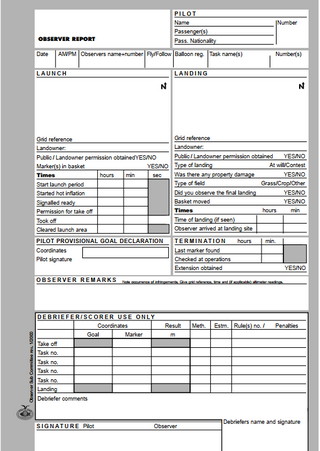
Home | Balloon flights | Gîte | Route | Links | Photos | Contact | Baptism ceremonies | Weather Tel. +33 (0)4 73 85 31 57 ![]()
![]()

Getting to the goal
The flight becomes a precision competition task, as in official national, European and World championships. Using the different wind directions at different altitudes and currents caused by the landscape (hills, valleys) close to the ground, the pilot tries to navigate to a preset goal or target. As the balloon has no rudder and no propulsion, this is actually quite difficult. Only a small minority of balloon pilots are true competition flyers. It can only be done with small, agile balloons, not with large commercial transport craft.
To mark the position during the flight that the balloon gets closest to the goal, the pilot drops a 'marker' - a small sandbag with a long nylon tail carrying their competition number. The shortest distance wins (even if everybody gets blown kilometers away from the goal). There are many variants and combinations in the official list of tasks: choices of multiple goals, angles (involving multiple marker drops), greatest distance between two markers inside a limited scoring area (called a Maximum Distance Double Drop), or the shortest distance between two markers in two scoring areas separated between an invalid area like a road, river, canal, lake.. (minimum distance double drop), and many more. In tough championships, pilots often have to accomplish two, three or even four tasks during a single flight.
Our passengers get to play the role of an 'observer' - an independent official who accompanies the team and notes every important occurrence: launch, landing, marker drops, rule infractions, times and positions. Only an observer or other official (measuring team) may touch a marker on the ground, and pick it up once its position has been accurately measured and noted. In many cases the result must be measured in a straight line across the land to a goal, target or between two markers, using a measuring tape. Beyond a certain distance from the goal the position is determined using a GPS.
Our pilot has participated in many championships (14 times Dutch nationals, French nationals, Coupe d'Europe, World Grand Prix...), and was also an official observer during many European and Word Championships. He was also the 'chief observer' of the Dutch ballooning federation, co-founder of the Dutch Balloon Competition Club, co-organizer of many Dutch national championships and has trained observers and co-designed the observer report form that has been in use by the international ballooning commission for more than 20 years in official championships. So he can explain how this all works.
This option is entirely free, but is does take extra time. Count on spending another hour after the landing searching for and measuring the positions of one or more markers.
Mention your interest on the flight information form if you want to try this.

Funny version
The stories of strange and funny adventures by observers while searching for and measuring markers are legion. They are found hanging in trees, dropped in ditches and ponds with the tail still floating, hanging out of the mouth of cattle that tried to eat them, kidnapped by the public, picked up from gutters on barns...
If the observer option is part of the special adventure for '3 Feathers' or 'Crazy Ladies' we can turn the marker recovery/measuring into a funny obstacle task that may involve climbing, crawling, wading, swimming... And if the flight and related fun is part of a hen party or similar crazyness, any 'supporters' present can participate as 'measuring team'.





